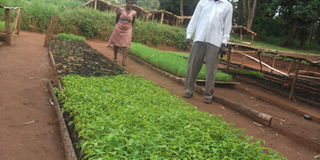How growing trees on the farm leads to food security

Trees need special attention before they are planted on the farm. So, setting them up in nurseries is the way to ensure this. PHOTO BY LOMINDA AFEDRARU
It is important to plant different tree species in crop lands because they contribute to higher productivity of crops and animals as well as the soil. Trees from legume families fix nitrogen, which is useful for crops. Trees also provide fuel wood for cooking and lighting, fodder for livestock, timber for construction, and also help to remove carbon in the air.
Farms, which have few trees especially in arid and semi-arid lands, suffer from higher temperatures and wind. Farmers are likely to have less mulching material thus losing nutrients and water.
Against this backdrop, Makerere University School of Agriculture and Environmental Sciences has been running a project in Manafwa District on farmers growing trees for food security and generate income.
The three-year project has had a number of farmers intercropping while others using part of their land for trees mainly pine and Eucalyptus. Alongside this one, another project was launched to be administered side by side with the current one.
The new project worth $3m (Australian dollars) is funded by the Australian government through University of Adelaide. It will be implemented in Uganda in Manfwa and Kapchorwa districts.
Zambia is the other country of focus for this project. Also, under the project, students from Uganda and Zambia will be selected to pursue related courses at University of Adelaide.
Dr Prossy Isubikalu, the project coordinator in Uganda, explains that the gist is to engage farmers in extensive tree planting alongside their agricultural activities. However, the aspect of processing and marketing tree products was lacking.
That is why the current project aims to bring on board farmers to form functional groups, which will make it easier to identify markets for their agricultural commodities including tree products. The main actors of this project are scientists from Makerere University School of Agriculture and Environmental Sciences with their counter parts from the National Forestry Resources Research Institute (NaFORRI).
“When we talk of food security and incorporating tree growing, we mean provision of sufficient food with the required diet. This therefore means farmers using improved seed and practicing commercialised agriculture,” says Dr Agona, the director general, National Agricultural Research Organisation (Naro).
Other factors to consider is sustainable natural resources management. In places like Manafwa and Kapchorwa, which are on mountain slopes, this should be considered for co-existence of agroforestry and other forms of agricultural production.
Dr Hilary Agaba, the director, NaFORRI, reveals that the current project’s span is four years with the focus on market access and agroforestry value chains.
Farmers in the two districts will be sensitised on the contribution of forestry to economic development, and how growing trees can better their income.
In providing an overview of the link between trees and food security for smallholder farmers, Dr Catherine Muthuri from World Agroforestry Centre (ICRAF), explains that in a similar project conducted in Burundi, Rwanda and Ethiopia, sensitising the farmers was an opportunity for the farmers but for her team to learnt about the challenges as well.
Farmers should be trained on skills such as grafting, nursery management and intercropping. For instance, growing certain tree species as shade for certain crops like coffee can be of help during dry seasons. A farmer, who is interested in growing trees on his or her land, should consult experts on selection of tree species or about the characteristics of different trees.
Unlike crops, trees need tender care when young and it is advisable to establish them in a nursery. Farmers can establish their own nursery as individuals or in groups in order to earn income from selling the seedlings.
some of the recommended trees to grow
Some of the trees that farmers in East Africa are encouraged to grow include Croton Mocrstachyus commonly known as brood leaved croton, which is used for controlling soil erosion and its leaves can be used for mulching.
It germinates within 30 to 40 days from the day of sowing.
Another is East Africana cardia, which has high quality timber and good for processing furniture. It is known for providing good bee forage.
When planting, its seeds need pre-treatment and it germinates between 40 to 60 days from planting. It is suitable for intercropping.
Experts further recommend farmers to grow Erythrina abyassinica, commonly known as flame tree because it is good for fodder for animals, controls soil erosion and can be used as firewood.
Farmers simply have to plant the propagated seedling without pre-treatment. It germinated within 25 days from planting.
Another tree species good for livestock feed is Fiadherbia albida commonly known as apple ring acacia.
It is good for containing soil fertility through nitrogen fixing and the seedlings germinate between 6 to 30 days.
It is good for intercropping because the leaves usually fall a lot thereby reducing shedding on the crops.




